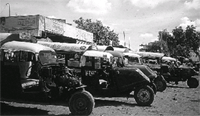KOTA
 "Kota is fast becoming like Delhi in matters of pollution. What we have here is an exploding situation," says Nishith Arora, a dentist living in Kota. The story of airpollution in the Rajasthan city begins with industry and ends with vehicles.
"Kota is fast becoming like Delhi in matters of pollution. What we have here is an exploding situation," says Nishith Arora, a dentist living in Kota. The story of airpollution in the Rajasthan city begins with industry and ends with vehicles.
Kota is known for stone mining, mineral-based industries, cement factories, fertiliser and chemical units, and plants that produce synthetic fibres, textile and rayon. A number of polluting industrial units have been closed down in Kota following a Supreme Court order and the Rajasthan Pollution Control Board (rpcb) claims that air pollution levels have been falling. Yet, there are 35 large- and medium-scale industrial units and about 5,000 small-scale units in and around Kota, according to the District Industrial Centre. "Industrial air pollution is prevalent in Kota due to coal/gas-based thermal power plants, calcium carbide (and) nitrogenous fertiliser (units), steam generating boilers, and cement factories...." says the 1996-97 annual report of RPCB."The thermal power plant and its units are highly polluting," says Rajeev Pareek, regional officer, rpcb, Kota. "During winter, my car gathers a thick layer of coal dust if it is parked in the open, although [pollution] is a little lower in summer," says Ram Pal, senior physician and cardiac specialist in the medical college and mbs hospital, Kota.
According to D C Sharma, senior scientific project officer, rpcb, industry's contribution to air pollution has come down comparatively due to closing down of several polluting units and adoption of processes like reuse of waste. RPCB's air quality data reveal that spm is at a steady level in Anantpura, an industrial area, while it is increasing in the commercial area near the veterinary hospital - a clear pointer to rising vehicular emissions. rpcb officials also note that while Kota's spm level is decreasing, the nox and so2 levels are increasing. "In the present scenario, vehicular pollution accounts for 90 per cent of the air pollution in Kota," says Pareek.
The growing threat
Between 1976 and 1998, almost 1.8 million vehicles were registered in Kota - 76.7 per cent of them two-wheelers and almost all of them two-stroke. Diesel vehicles constitute 16.38 per cent of the total count, while petrol-driven four-wheelers comprise a mere seven per cent. Kota is also teeming with diesel-powered three-wheelers called tempos. And then there are hundreds of vehicles that pass along National Highway-12 that goes right through the heart of the city. According to Darshan Kumar, a contractor of a toll tax collection booth in Kota, a minimum of 2,000 vehicles pass through Kota everyday and "80 per cent of them are trucks". He estimates that the number of vehicles increases by at least 10 per cent each year.
"Due to the air pollution, you can find a lot of chronic diseases in Kota," says Anil Saxena, a physician at the mbs Hospital. "I have seen a rise in cases of allergies," says S P Srivastava, superintendent of the hospital. "Of the 150-odd cases of respiratory diseases that we get every day, more than 40 per cent are directly related to air pollution," says Saxena. He says that the lead content in the ambient air is very high. Lead can get deposited in bones and in soft tissues, especially among children, and affect intelligence and behaviour.
So who will address the issue? "We look after only industrial pollution, not vehicular pollution," says Pareek. The responsibility for that rests with the state's department of transport, he adds. Vehicles are checked for emission levels at a couple of fuel stations where pollution under control certificates are issued. This, quite obviously, is a farce.
The officials of the regional transport office (RTO) are not bothered. There are no records of vehicles checked for pollution. The regional transport officer himself was vague about the issue of pollution control: "I do not know anything about it. I have to read about all this." Says G K Gupta, a motor vehicle inspector in Kota: "We neither have the expertise nor the resources to carry out a large-scale pollution control drive." There seems to be absolutely no coordination between rpcb and the transport officials. Typical bureaucratic functioning is primarily to blame for the air pollution in Kota, rather than industry or vehicle owners.
Related Content
- Joint committee report on crocodile deaths in Rajasthan river, 24/02/2025
- Order of the National Green Tribunal regarding damage to river Chambal by concretization of the riverbed at Kota, Rajasthan, 07/11/2023
- Report by the Rajasthan State Pollution Control Board on the proposed solid waste transfer facility near Ummed Ganj Pakshi Vihar Conservation Reserve, Kota district, Rajasthan, 25/08/2023
- Order of the National Green Tribunal regarding Maru Mahotsav 2023, Jaisalmer, Rajasthan, 31/01/2023
- Reply by Aravalli Bachao Citizens Movement to the NGT on the protection of Aravalli from illegal sand and stone mining, 28/11/2022
- Order of the National Green Tribunal regarding pollution of Kala Talab, Kota, Rajasthan, 05/07/2022
